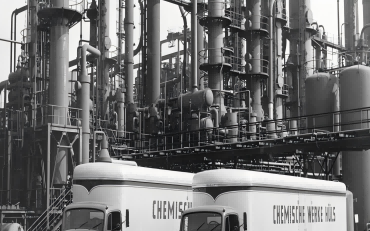Glacial Acetic acid tech grade
Acetic acid that contains a very low amount of water (less than 1%) is called anhydrous (water-free) acetic acid
or glacial acetic acid. The reason it's called glacial is because it solidifies into solid acetic acid crystals just cooler
than room temperature at 16.7 °C. Removing the water from acetic acid lowers its melting point by 0.2 °C.
Glacial acetic acid may be prepared by dripping acetic acid solution over a "stalactite" of solid acetic acid
(which could be considered to be frozen). Like a water glacier contains purified water, even if it's floating
in the salty sea, pure acetic acid sticks to the glacial acetic acid, while impurities run off with the liquid.
Caution: Although acetic acid is considered a weak acid, safe enough to drink in vinegar, glacial acetic acid
is corrosive and can injure skin on contact.


